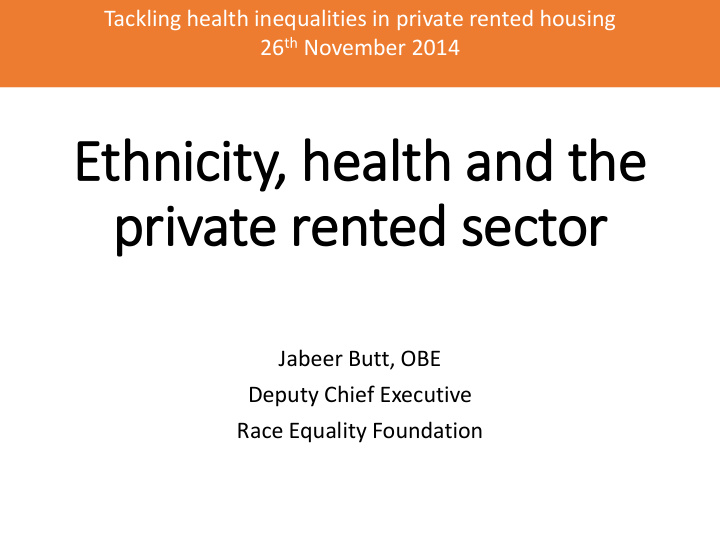



Tackling health inequalities in private rented housing 26 th November 2014 Ethnicity, health and the private rented sector Jabeer Butt, OBE Deputy Chief Executive Race Equality Foundation
Megan McFarlane (2014) Ethnicity health and the private rented sector, Better Housing Briefing, No 25, Race Equality Foundation Available for download at: www.better-housing.org.uk
There has been a marked increase in the actual and relative number of households living in the private rented sector CHOICE & INSECURITY, FLEXIBILITY VS. UNPREDICTABLE RENT LEVELS & HOUSING CONDITIONS • 9 million private renters in England- PRS larger than social rented sector for first time since 1960s • PRS housed 1.7m (9%) households in England in 1992, 3.9m (18%) households in 2013 • Particularly rapid since 2001, with the introduction of Buy to Let mortgages and rising property values
Poor housing conditions are more prevalent in the private rented sector compared to both the owner occupied and social rented sectors • More than 3m homes in England fail to meet the HHSRS HOUSING HEALTH AND ‘minimum standard’ SAFETY RATING SYSTEM • % non-decent homes higher in PRS (HHSRS) = 29 H & S HAZARDS IN HOUSING • Increasing proportion of PRS households in poverty • Caused by “light - touch” approach to regulation? (exclusion from Decent Homes Standard), “part - time” or “accidental” landlords? % non-decent homes • Increasing power imbalance between tenants and landlords Social 15 (increasing demand, rising rent, short fixed-term contracts, Owner/oc… 20 PRS 33 Section 21 notices) 1 / 33 0 20 40 1 / 8 2001 2011 HAVE NOT ASKED FOR REPAIRS EVICTED, SERVED NOTICE OR THREATENED OR CHALLENGED RENT PRS households WITH EVICTION IN PAST in poverty INCREASE IN LAST YEAR 5YRS FOR COMPLAINING 10% BECAUSE OF FEAR OF 18% ABOUT PROBLEMS EVICTION
Black and minority ethnic households and recent migrants are more likely to be living in the private rented sector • Ethnic minority households overrepresented in PRS • Proportional increase of renters highest for these ethnic minority households groups are “more likely to live in • Most recent migrants are renters- often only homes with problems accessible tenure (unable to obtain mortgage, not related to damp and social housing) disrepair, to live in areas with problems in the local PERCENTAGE IN PRS environment, and to live in overcrowded conditions VS. 56.5% 15% 31% than households with a VS. white HRP” (DCLG, 2013b). WHITE BME MIGRANT HOUSEHOLDS HOUSEHOLDS HOUSEHOLDS
Poor housing contributes to a range of health and wellbeing impacts OVERCROWDING COLD & DAMP • Associated with cardiovascular conditions, • associated with depression, anxiety respiratory diseases, increased risk of falls, isolation, social deprivation, mental health problems, arthritis, rheumatism infectious diseases • Average of 26,700 ann. excess winter deaths • TB cases per 100,000 people X 10 [Dec- Mar] times higher amongst non-UK born residents • 4% BME HHs experienced Cat. 1 cold (vs. 6% white HH) • BME HHs X 6 more likely to be overcrowded • Using Hills def. [diff between a HH’s required fuel costs and what these costs would need to be for them not to be in fuel poverty] 16% BME HHs vs. 10% white HHs
Poor housing contributes to a range of health and wellbeing impacts BEDS IN SHEDS HOMELESSNESS • Illegally rented accommodation • Loss of PRS tenancies increasingly => (outhouses, garages, sheds) homelessness • Up 75% in North, up to 316% in London • Usually fail to meet H&S standards, lack • Influence of welfare reform i.e. caps on Local electricity, running water and fire safety Housing Allowance, bedroom tax (spare-room • In London in last 5yrs, Fire Brigade subsidy) attended 438 fires in illegally occupied • BME people more likely to become buildings => 69 serious injuries and 13 homeless/be affected by “hidden deaths homelessness” • Migrants, refugees and asylum seekers may • LFB taken formal enforcement be at risk due to a lack of support networks, action on around 200 occasions limited familiarity with benefits systems, lack of entitlement to benefits and services • 2013-14, 54% of rough sleepers in London = non-UK nationals, 31% from Central and Eastern European
There has been a range of responses to address the issue of poor standards in the private rented sector • £3 million fund for English councils to tackle issues relating to PRS, such as illegally rented outhouses. • National taskforce to address ‘beds in sheds’ and guide to dealing with ‘rogue landlords’. • Government proposals include: specific protections against retaliatory evictions, the right to reclaim rent using Rent Repayment Orders, Tenants' Charter to give those in the private rented sector “ a better understanding of what they can expect and, if something goes wrong, where to go for help ” (DCLG, 2014b). • Proposals focused on strengthening tenants’ rights to access finance for energy improvements similar to the Green Deal model. • Labour plans focus on promoting stability within the sector through the standardisation of three-year tenancies and controlled rent increases (Labour Party website, 2014). • Support organisations for private renters: information services, private tenant advocates or campaigning organisations.
Recommend
More recommend